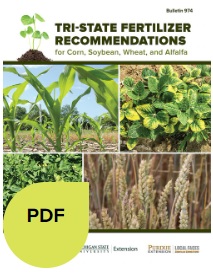Agronomy, Conservation, Homepage Slider, Water Quality
High Fertilizer Prices and Soil Sampling
By Greg LaBarge, Ohio State University Extension
Fertilizer prices have been on a steady march higher throughout 2021. USDA’s Agricultural Marketing Service tracks Illinois fertilizer prices which the state FarmDoc group has summarized and published an article with prices through July 2021. When compared to prices from one year ago, anhydrous ammonia was up 53%, DAP was up 83%, and potash was up 71%. The actual cost per ton of anhydrous ammonia is $746, DAP was $717, and potash was $600. You can find the entire article at https://go.osu.edu/fertprices.

What is the best investment when fertilizer prices are high, a recent, reliable soil test! So what is a recent reliable soil test? A recent soil test is no more than four years old. A reliable test is where you believe the number for pH, phosphorous, and potassium on the soil test represents that field you farm. If you do not trust the soil test number on the report, it isn’t beneficial. If you question your soil report numbers, think about changing how you collect samples for soil testing. You want to consider three things: how much area is sampled with each sample, how deep you are sampling, and what lab you are using.
Yield or past soil test results should drive sample area size decisions. A single sample should not represent more than 25 acres. Grid or zone sampling often results in zone sizes of two to twelve acres and target lime or nutrients to areas of greatest need. Sample depth should be consistent. For sample depth, our Tri-State Fertilizer Recommendations use an 8-inch sample core. Mark your probe at your selected depth. Throw out and take another sample core when cores are compacted in the probe. We like to blame the lab for bad samples, but we generally see more variability in the sample collection process than laboratory procedures. If you want more information on soil sample collection procedures, see the factsheet at https://go.osu.edu/soilsample.
Recent, reliable soil test values for pH, phosphorus, and potassium will tell you if you need to apply lime or fertilizer this year or if we can wait. Comparing your soil test values to the Tri-State Fertilizer Recommendations will answer critical questions about your fertility needs. Get your copy of the Tri-state Fertilizer Recommendations for Corn, Soybean, Wheat, and Alfalfa at https://go.osu.edu/fertilizer. The publication is available for sale as a printed copy or a free pdf version.
The first thing to look at on your soil test reports is pH. Soil pH is the critical factor in nutrient availability. If soil pH is less than 6.0, consider liming before making any fertilizer application. When soil pH values are acidic, investing in lime will make more soil stored phosphorus and potassium plant available. Correct soil pH will make other parts of your fertility program more efficient. Spend your fertilizer dollars on lime first.
You have been using a build maintenance fertilization strategy if you have been following our Tri-state Fertilizer Recommendations for Corn, Soybean, Wheat, and Alfalfa. Comparing your soil test value for phosphorus and potassium to the critical level defines the need for annual fertilizer application. The text from the recommendation bulletin states, “Soil test levels above the critical level are “optimal,” unlikely to be responsive to fertilizer application. Soil test levels below the critical level are “deficient,” more likely to have a yield response to fertilizer application.” Shown in Table 1 are critical soil test values for phosphorus and potassium in corn, soybean, wheat, and alfalfa.
Table 1. Critical Soil Test Values from Mehlich 3 Soil Test for Phosphorus and Potassium. From Tri-state Fertilizer Recommendations for Corn, Soybean, Wheat, and Alfalfa, 2020.
| PhosphorusMehlich 3 | PotassiumMehlich 3 | ||
| Crop | Soils with CEC <5 meq/100g | Soils with CEC >5 meq/100g | |
| Corn & Soybean | 20 | 100 | 120 |
| Wheat & Alfalfa | 30 | 100 | 120 |
If your crop for 2022 is corn or soybeans, here is how it works. First, scan your soil test reports for P soil values less than 20 ppm. Below 20 ppm is the situation where the risk of yield loss is high. Therefore, the recommendation would be to apply a crop removal rate of P. Determine expected yield based on field productivity. Then multiply the expected yield by the crop removal for P by crop. Crop removal is 0.35 pounds P2O5 per bushel for corn, and soybean is 0.20 pounds P2O5per bushel.
Here is an example:
- A field (or zone) with a soil test P value of 15 ppm Mehlich 3, and corn yield is 195 bushels per acre.
- Therefore, the nutrient needed is 68 pounds P2O5,which is 195 multiplied by 0.35.
- The amount of MAP fertilizer required to meet this need is 131 pounds found by taking 68 pounds P2O5needed divided by 0.52, which is the P2O5 percentage of MAP, 11-52-0.
- If you are using DAP, it would be 148 pounds found by taking 68 pounds P2O5needed dividing by 0.46, which is the P2O5 percentage of DAP,18-46-0.
Where your soil test reports show soil P values above 20 ppm critical level, you can defer fertilizer applications until when fertilizer prices are more favorable. However, keep in mind that if your soil test values are near the critical level, you can only defer for a short time. Soil test P values decline over time, but change is not dramatic from one year to the next due to the soil’s ability to buffer available P. Estimated change in soil test P values is only 2-3 ppm per year from crop removal.
Decisions for potassium are similar to phosphorus. The difference is we need to look at both the Cation Exchange Capacity (CEC) number and the soil test potassium value. If CEC is less than 5, use 100 ppm Mehlich as the critical level. If CEC is greater than 5, use the 120 ppm value. The crop removal for corn is 0.20 pounds of K2O per bushel, and for soybean, it is 0.80 pounds of K2O.
We continue with our example of a field (or zone) with a 195 bushel per acre corn yield and a soil test K level of 110 and CEC of 15 meq/100g.
- The K2O need would be 39 pounds per acre, 195 multiplied by 0.20.
- The potash fertilizer recommendation would be 65 pounds. Take the 39 pounds K2O needed divided by 0.60, the K2Opercentage of potash, 0-0-60.
Where your soil test reports show soil K values above 120 ppm critical level, you can defer fertilizer applications until fertilizer prices are more favorable. However, keep in mind that if your soil test values are near the critical level, you can only defer for a short time. While soils are good at buffering K and P, soil test K values tend to decline more quickly than phosphorus. The estimated change in soil test K values is 6-10 ppm per year from crop removal.
We provide a spreadsheet that many folks have found useful to do nutrient and fertilizer calculations. You can find that tool at https://go.osu.edu/ohiofertilitytool.